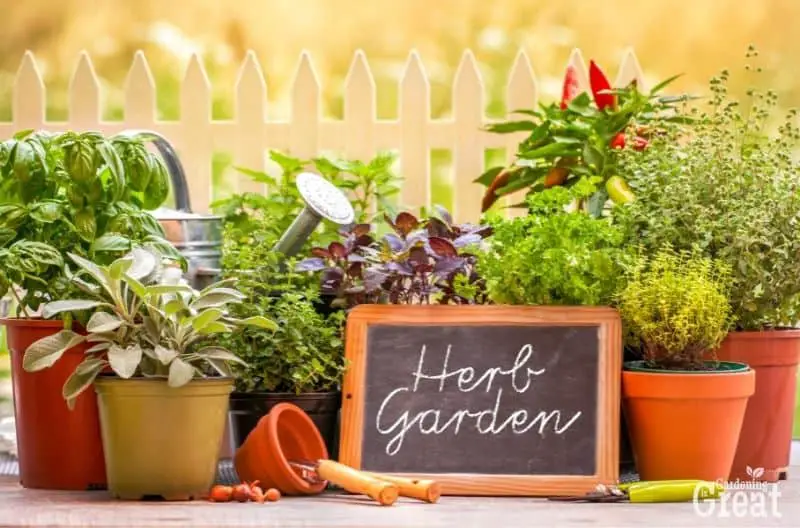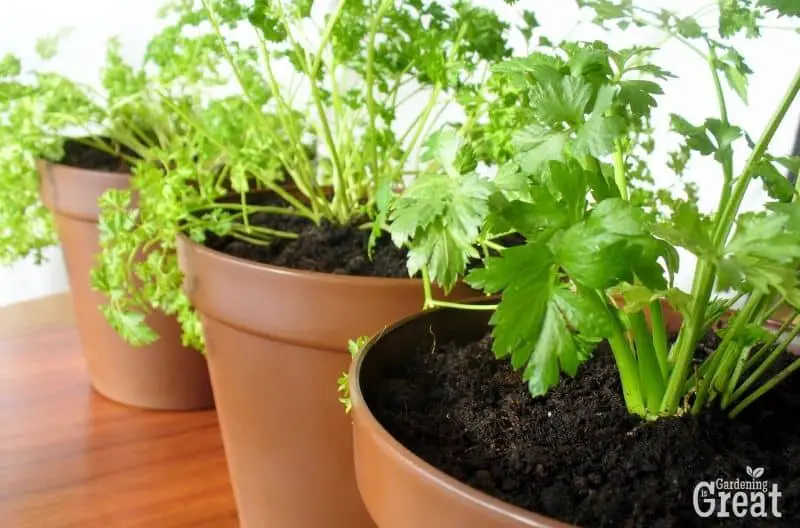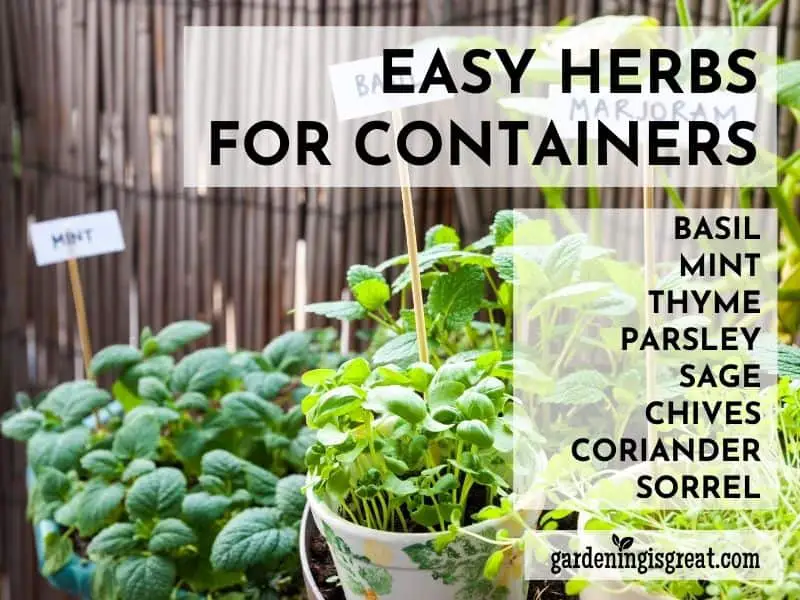8 Easiest Herbs to Grow in Pots
Whether you have a patio or live in an apartment, you may be considering growing herbs in pots.
Herbs are considered an easy choice of plant to grow and can do quite well in containers. But which herbs are the easiest to grow in pots and what care do they need to grow healthily?
In this post, I will share 8 of the easiest herbs to grow in pots along with top tips for growing herbs in containers.

This post contains affiliate links that earn me a commission at no additional cost to you.
[toc]
Can Herbs Grow in Pots?
Before diving into the easiest herbs to grow in pots, let’s consider whether you should plant herbs in pots in the first place.
The simple answer is yes!
People choose to grow herbs in pots for several reasons:
- Easy access from the kitchen
- Small garden
- Living in a rental property
- Patio garden
- Choosing to grow inside.
Herbs can do very well growing in pots as long as the right size for each herb’s growth has been considered, along with providing sunlight and drainage.

Top Tips for Growing Herbs in Pots
1. Pot size
When growing your herbs from a seed, it is best to grow them in smaller-sized pots of growing trays. Add 1-2 seeds per pot so the plants are not overcrowded for growing roots and stems.
After the seeds have germinated, transfer them into a larger pot so they have space to grow.
2. Keep the soil moist
Herbs need moist soil. If soil is too dry, herbs cannot grow, whereas if the soil is too wet, the herbs can die.
It is best to add a little water to the soil before planting your herbs and then regularly watering the soil so that it remains moist to touch.
3. Add compost
Compost is full of nutrients that help herbs to grow healthy and strong. Compost is also not as tightly packed as soil, and so is good for draining excess water.
4. Provide sunlight
Whether you choose to keep your herbs indoors or outdoors, they need to have access to direct sunlight for at least a few hours a day. Having access to sunlight enables your herbs to grow
Now that you know how to take care of your herbs in pots, let’s take a look at 8 of the easiest herbs to grow in pots.

For more top tips on growing herbs, take a look at this guide to growing herbs for beginners.
8 Easiest Herbs to Grow in Pots
Basil
Basil needs direct sunlight so is best placed where the part of your garden gains the most amount of sun. You can grow different varieties such as Dolce Fresca, Genovese, and Spicy Globe.
Basil is an annual herb which means it needs replanting every year. When watering, focus on watering the base of the plant rather than the leaves.
When you want to cook with basil, ensure to only cut the leaves you wish to cook with rather than cutting the plant as this enables new leaves to grow.
Mint
Mint does very well grown in pots but needs good drainage so ensure the pots have holes in to release excess water.
Due to how quickly it spreads, it is a herb best kept in a container to stop it from competing with other plants.
Mint is a perennial plant and can regrow every year. With that in mind, it is best to trim and cut back each year to allow new leaves to grow.
Thyme
Thyme is a perennial plant and so grows back every year. Thyme grows best in pots that are placed in the full sun and are well-drained.
To protect them from the frost, it is best to bring them indoors in the winter. It is good to regularly trim back your thyme to encourage new leaves to grow.
When growing thyme in pots, initially ensure the compost is moist. But after initially planting, thyme thrives in almost dry conditions.
Parsley
Parsley is an easy-to-grow herb when planted in containers. It can be grown in partial sunlight and needs well-drained soil, though they do need watering regularly.
It is a biennial plant so needs to be replanted from seeds every year. To have a consistent supply of parsley it is recommended to plant new seeds every few weeks.
When harvesting parsley, it is best to cut at the stems to allow new leaves to grow back.
Sage
Different varieties of sage are either annual, biennial, or perennial. Annual and biennial sages need to be regrown from seeds every year. Whereas perennial sages just need trimming back and regrow each year.
Growing sage in pots does best when placed in full sunlight. But ensure the pots have good drainage.
To harvest sage, pick the leaves before the flowers show as this is when the leaves are most aromatic and fresh.
Chives
Chives are a perennial plant and so will grow back every year. Chives can grow well in pots but need to be well-drained and placed in full or partial sunlight.
This herb needs to be well-watered, much more so than thyme. When growing chives in pots, they need to be repotted every couple of years to support their health.
Chives can be cut from the base to enable more leaves to grow. However, remember to cut off the flower as these are inedible.
Coriander/Cilantro
Coriander needs to be potted in moist soil which has good drainage. Similar to chives, coriander needs to be regularly watered. It also needs to be in full sunlight so ensure to place your coriander pot in the sun.
Being a perennial herb, coriander grows back every year. Dividing growing seedlings and planting in separate pots can help increase the supply of coriander.
To harvest, cut the leaves at the base of the stalk as the stalk contains the most flavor. You can also harvest and eat the flowers which can be used in salads.
Sorrel
Sorrel is a perennial plant that can regrow each year. It is a relatively easy herb to grow in pots and requires full sun or partial shade. Sorrel needs to be well-watered, but like all herbs, ensure the pot has good drainage in place.
It is recommended to regularly pick leaves to encourage new growth. Every year, divide and replant sorrel for new growth and healthier leaves.
This list of herbs is a great starting point for growing your herb garden. These 8 herbs are some of the easiest to grow in pots enabling you to add fresh flavors to your food from your very own herb garden.
Growing herbs in pots enable you the flexibility of moving pots and controlling the size of your herbs to suit your available space.
Still not sure what herbs you want to plant in your herb garden? Take a look at some of our suggestions for herbs from around the world you can grow at home:
